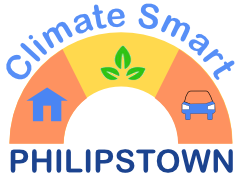Jan 9, 2022
By Krystal Ford - Climate Smart Coordinator
Batten Down the Hatches
Over the first five winters, I never felt warm, even with the thermostat was turned up. When we got the oil bill, it added insult to injury.
My house isn’t old — it was built in 1984 — but its drafts were strong. Over the first five winters, I never felt warm, even with the thermostat was turned up. When we got the oil bill, it added insult to injury.
Unfortunately, many of us suffer from the same problem: under-insulated homes that are too hot in the summer and too cold in the winter.
I often hear from people who are looking to do the right thing for the environment and to save money who want to put solar panels on their roof. And while I support solar as an alternative energy, I wouldn’t start there. I would end there.
The first step to a more energy efficient home is not sexy or sleek: It is identifying where you are losing energy and weatherizing. And it can make difference in your pocketbook and the community: how we heat our homes and businesses accounts for the second highest source of carbon emissions in Philipstown. The first is on-road transportation.
Four years ago, we decided to order a home energy audit through a federal program called Healthy Homes. I found them through the NY State website listing home energy auditors. A contractor came out and did what is known as a blower-door test (he sealed everything off, then ran a fan out one door to locate air leaks); used an infrared camera to locate heat loss; checked the air quality, and then presented us with a report with recommendations. In our case that mean insulating the attic, spray foaming the crawl space and sealing up cracks.
It worked. We felt much more comfortable. We didn’t feel the drafts like we used to and temperature held more evenly. It also reduced our oil bill by about a third.
I will be the first to admit, it can seem overwhelming. It helps to have someone to walk you through it. A great resource called Mid-Hudson Energy Choices provides free help to residents and businesses. Collin Adkins is one of their community energy advisers.
Is there a hierarchy of doing stuff in the house? Big ticket item wise?
Basic energy improvements to the building envelope like insulation and air-sealing are often overlooked but are still to this day some of the best bang for your buck. Once your home is consuming less energy, big-ticket items like a heat pump or solar panels become a much savvier investment. The 1-2-3 punch to a cleaner, greener, cozier home is: 1) energy efficiency upgrades; 2) electrify your heating and cooling with air- or ground-source heat pumps; 3) generate your own clean energy with solar photovoltaic panels.
What does a home energy audit cost?
You can get an assessment for free through a program provided by the New York State Energy Research and Development Authority (see nyserda.ny.gov/All-Programs/Energy-Audit-Programs), but you might have to pay for a blower-door test. [What would that be? Range?]
Some of this can be expensive. Is there financing?
Lower-income homeowners and renters can receive $5,000 to $10,000 in home energy upgrades through NYSERDA. There is also low-cost financing available for a range of upgrades, including envelope improvements, heat pumps and solar panels.
What sort of feedback do you get from people who do these energy audits?
The people who invest in upgrades are often surprised at all the other benefits besides the dollar and energy savings. It's not uncommon to hear that they feel more comfortable, healthier, more optimistic. In that way, upgrades can be a gateway to some truly remarkable transformations.
Residents of Putnam and Dutchess counties can reach a community energy adviser at MidHudsonEnergyChoices.org or by calling 845-677-8223.




